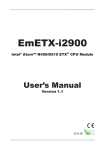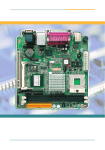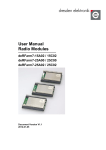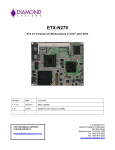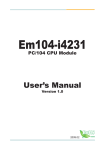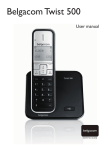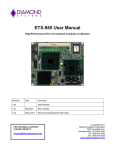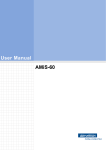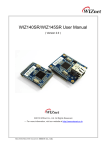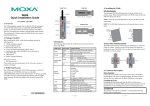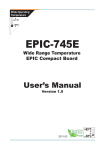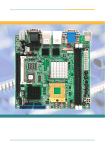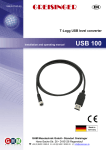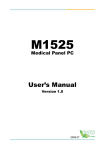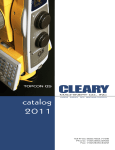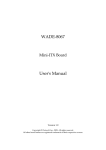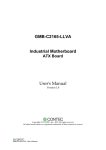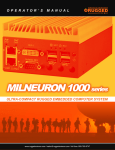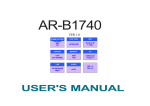Download ETX-742E
Transcript
85 ETX-742E Wide Range Temperature Intel® Atom™ N450 ETX® CPU module User’s Manual Version 1.1 85 Copyright® 2014 All Rights Reserved. 2014.08 This page is intentionally left blank. Table of Contents Chapter 1 - Introduction............................................. 1 1.1 Copyright Notice........................................................2 1.2 About This User's Manual.........................................2 1.3 Warning.......................................................................2 1.4 Replacing the lithium battery....................................3 1.5 Technical Support......................................................3 1.6 Warranty......................................................................3 1.7 Packing List................................................................4 1.8 Ordering Information.................................................4 1.9 Specifications.............................................................5 1.10 Board Dimensions and Layout...............................6 Chapter 2 - Installation............................................... 7 2.1 Jumpers and Connectors.........................................8 2.2 Block Diagram .........................................................11 2.3 Driver Installation Paths ........................................12 Chapter 3 - BIOS....................................................... 13 3.1 BIOS Main Setup......................................................14 3.2 Advanced Settings...................................................16 3.2.1 CPU Configuration.............................................17 3.2.2 IDE Configuration..............................................18 3.2.3 Floppy Configuration.........................................20 3.2.4 Super IO Configuration.....................................21 3.2.5 Hardware Health Configuration........................23 3.2.5 USB Configuration.............................................24 3.3 Chipset.......................................................................26 3.3.1 North Bridge Chipset Configuration................27 3.3.2 South Bridge Chipset Configuration................28 3.4 PCIPnP.......................................................................29 3.5 Boot............................................................................30 3.5.1 Boot Setting Configuration...............................31 -i- 3.6 Security.....................................................................32 3.7 Exit...........................................................................33 3.8 AMI BIOS Checkpoints............................................35 3.8.1 Bootblock Initialization Code Checkpoints.....35 3.8.2 Bootclock Recovery Code Checkpoints..........37 3.8.3 POST Code Checkpoints...................................39 3.8.4 DIM Code Checkpoints......................................43 3.8.5 ACPI Runtime Checkpoints...............................45 Appendix................................................................... 47 Appendix A: I/O Port Address Map.......................................48 Appendix B: Interrupt Request Lines (IRQ).........................51 Appendix C: Watchdog Timer (WDT) Setting.......................52 - ii - Introduction 1 Chapter 1 Introduction Chapter 1 - Introduction -1- Introduction 1.1 Copyright Notice All Rights Reserved. The information in this document is subject to change without prior notice in order to improve the reliability, design and function. It does not represent a commitment on the part of the manufacturer. Under no circumstances will the manufacturer be liable for any direct, indirect, special, incidental, or consequential damages arising from the use or inability to use the product or documentation, even if advised of the possibility of such damages. This document contains proprietary information protected by copyright. All rights are reserved. No part of this manual may be reproduced by any mechanical, electronic, or other means in any form without prior written permission of the manufacturer. 1.2 About This User's Manual This User’s Manual is intended for experienced users and integrators with hardware knowledge of personal computers. If you are not sure about any description in this User’s Manual, please consult your vendor before further handling. 1.3 Warning Single Board Computers and their components contain very delicate Integrated Circuits (IC). To protect the Single Board Computer and its components against damage from static electricity, you should always follow the following precautions when handling it : 1. Disconnect your Single Board Computer from the power source when you want to work on the inside. 2. Hold the board by the edges and try not to touch the IC chips, leads or circuitry. 3. Use a grounded wrist strap when handling computer components. 4. Place components on a grounded antistatic pad or on the bag that came with the Single Board Computer, whenever components are separated from the system. -2- Introduction 1.4 Replacing the lithium battery Incorrect replacement of the lithium battery may lead to a risk of explosion. The lithium battery must be replaced with an identical battery or a battery type recommended by the manufacturer. Do not throw lithium batteries into the trashcan. It must be disposed of in accordance with local regulations concerning special waste. 1.5 Technical Support If you have any technical difficulties, please do not hesitate to call or e-mail our customer service. http://www.arbor.com.tw E-mail:[email protected] 1.6 Warranty This product is warranted to be in good working order for a period of two years from the date of purchase. Should this product fail to be in good working order at any time during this period, we will, at our option, replace or repair it at no additional charge except as set forth in the following terms. This warranty does not apply to products damaged by misuse, modifications, accident or disaster. Vendor assumes no liability for any damages, lost profits, lost savings or any other incidental or consequential damage resulting from the use, misuse of, or inability to use this product. Vendor will not be liable for any claim made by any other related party. Vendors disclaim all other warranties, either expressed or implied, including but not limited to implied warranties of merchantibility and fitness for particular purpose, with respect to the hardware, the accompanying product’s manual(s) and written materials, and any accompanying hardware. This limited warranty gives you specific legal rights. Return authorization must be obtained from the vendor before returned merchandise will be accepted. Authorization can be obtained by calling or faxing the vendor and requesting a Return Merchandise Authorization (RMA) number. Returned goods should always be accompanied by a clear problem description. -3- Introduction 1.7 Packing List Before you begin installing your single board, please make sure that the following materials have been shipped: 1 x ETX-742E ETX® CPU Module 1 x Driver CD 1 x Quick Installation Guide If any of the above items is damaged or missing, contact your vendor immediately. 1.8 Ordering Information ETX-742E Intel® Atom N450 1.6GHz ETX® CPU Module HS-0742-F2 PBE-1000 R2.1 Heat spreader 114 x 95 x 18mm ETX® evaluation board in ATX form factor CBK-05-1000-00 Cable kit for PBE-1000 R2.1 -4- Introduction 1.9 Specifications Form Factor ETX CPU Module CPU Chipset Intel® Atom™ N450 at 1.6GHz Processor Intel® ICH8M System Memory 1 x 200-pin SO-DIMM socket Up to 2GB DDR2 667MHz SDRAM Intel® Graphics Media Accelerator 3150 VGA/ LCD Controller Integrated with Analog RGB/ Single Channel 18-bit LVDS Ethernet 1 x Realtek 8103EL PCIe 10/100 Base-T Ethernet BIOS AMI PnP Flash BIOS Serial ATA 2 x Serial ATA with 300MB/s HDD transfer rate IDE Interface 2 x Ultra ATA, support 4 IDE devices Serial Port 2 x COM ports Parallel Port 1 x SPP/EPP/ECP mode 1 x Floppy connector, shared with Parallel Port #1 KBMS Supports PS/2 interface Keyboard and Mouse Universal Serial Bus 4 x USB 2.0 ports LCD Single Channel 18-bit LVDS Expansion Interface 4 x PCI masters ISA Bus LPC interface Operation Temp. -40oC ~ 85oC (-40oF~185oF) Watchdog Timer 1~255 Level Reset Dimension (L x W) 114 x 95 mm ( 4.5 ” x 3.7 ” ) -5- Introduction 1.10 Board Dimensions and Layout SATA 5.30 SODIMM 4.00 Ø2.5 .08 Ø5 44.45 42.16 40.13 90.00 0 95.00 55.63 51.06 108.00 3.00 2.50 33.78 72.90 Unit: mm 114.00 IDE1 IDE2 LAN SMbus Miscellaneous ISA bus VGA LCD IrDA Serial Ports Parallel Port Floppy Keyboard Mouse PCI bus USB Audio -6- Installation 2 Chapter 2 Installation Chapter 2 - Installation -7- Installation 2.1 Jumpers and Connectors SATA1, SATA2 Connectors (Top side) Pin Description 1 GND 2 TX+ 3 TX- 4 GND 5 RX- 6 RX+ 7 GND 1 7 LPC1 Connector Connector type: FPC12-14P-P0.5 (Hirose) Pin Description 1 LAD0 2 LAD1 3 LAD2 4 LAD3 5 GND 6 LFRAME# 7 INT_SERIRQ 8 BUF_PLT_RST# 9 GND 10 PCLK_CONN 11 GND 12 GND 13 +3.3V 14 +3.3V 1 14 -8- Installation ETX1 Connector A1 A3 A5 A7 A9 A11 A13 A15 A17 A19 A21 A23 A25 A27 A29 A31 A33 A35 A37 A39 A41 A43 A45 A47 A49 A51 A53 A55 A57 A59 A61 A63 A65 A67 A69 A71 A73 A75 A77 A79 A81 A83 A85 A87 A89 A91 A93 A95 A97 A99 GND PCICLK3 GND PCICLK1 REQ#3 GNT#2 REQ#2 REQ#1 GNT#0 VCC SERIRQ AD0 AD1 AD4 AD6 CBE#0 AD8 GND AD10 AD11 AD12 AD13 AD14 AD15 CBE#1 VCC PAR PERR# PME# LOCK# TRDY# IRDY# FRAME# GND AD16 AD17 AD19 AD20 AD22 AD23 AD24 VCC AD25 AD28 AD27 AD30 PCIRST# INTR#C INTR#A GND ETX2 Connector GND PCICLK4 GND PCICLK2 GNT#3 VCC3 GNT#1 VCC3 N.C VCC REQ#0 VCC3 AD2 AD3 AD5 AD7 AD9 GND AUXAL MIC AUXAR ASVCC SNDL ASGND SNDR VCC SERR# N.C USB2DEVSEL# USB3STOP# USB2+ GND CBE#2 USB3+ AD18 USB0AD21 USB1CBE#3 VCC AD26 USB0+ AD29 USB1+ AD31 INTR#D INTR#B GND A2 A4 A6 A8 A10 A12 A14 A16 A18 A20 A22 A24 A26 A28 A30 A32 A34 A36 A38 A40 A42 A44 A46 A48 A50 A52 A54 A56 A58 A60 A62 A64 A66 A68 A70 A72 A74 A76 A78 A80 A82 A84 A86 A88 A90 A92 A94 A96 A98 A100 B1 B3 B5 B7 B9 B11 B13 B15 B17 B19 B21 B23 B25 B27 B29 B31 B33 B35 B37 B39 B41 B43 B45 B47 B49 B51 B53 B55 B57 B59 B61 B63 B65 B67 B69 B71 B73 B75 B77 B79 B81 B83 B85 B87 B89 B91 B93 B95 B97 B99 -9- GND SD14 SD13 SD12 SD11 SD10 SD9 SD8 MEMW# MEMR# LA17 LA18 LA19 LA20 LA21 LA22 LA23 GND SBHE# SA0 SA1 SA2 SA3 SA4 SA5 VCC SA6 SA7 SA8 SA9 SA10 SA11 SA12 GND SA13 SA14 SA15 SA16 SA18 SA19 IOCHRDY VCC SD0 SD2 SD3 DREQ2 SD5 SD9 IOCHK# GND GND SD15 MASTER# DREQ7 DACK#7 DREQ6 DACK#6 DREQ5 DACK#5 DREQ0 DACK#5 IRQ14 IRQ15 IRQ12 IRQ11 IRQ10 IO16# GND M16# OSC BALE TC DACK#2 IRQ3 IRQ4 VCC IRQ5 IRQ6 IRQ7 SYSCLK REFCH# DREQ1 DACK#1 GND DREQ3 DACK#3 IOR# IOW# SA17 SMEMR# AEN VCC SMEMW# SD1 NOWS# SD4 IRQ9 SD7 RSTDRV GND B2 B4 B6 B8 B10 B12 B14 B16 B18 B20 B22 B24 B26 B28 B30 B32 B34 B36 B38 B40 B42 B44 B46 B48 B50 B52 B54 B56 B58 B60 B62 B64 B66 B68 B70 B72 B74 B76 B78 B80 B82 B84 B86 B88 B90 B92 B94 B96 B98 B100 Installation ETX3 Connector C1 C3 C5 C7 C9 C11 C13 C15 C17 C19 C21 C23 C25 C27 C29 C31 C33 C35 C37 C39 C41 C43 C45 C47 C49 C51 C53 C55 C57 C59 C61 C63 C65 C67 C69 C71 C73 C75 C77 C79 C81 C83 C85 C87 C89 C91 C93 C95 C97 C99 GND R HSY VSY DETECT# TX2CLK# TX2CLK GND TX2D1 TX2D1# GND N.C. N.C. GND TX1D2# TX1D2 GND TX1D0 TX1D0# VCC DDC_DATA DDC_CLK BKLTCTL TV_DATA_COMP N.C. LPT/FLPY# VCC STB# N.C. IRRX IRTX RXD2 GND RTS#2 DTR#2 DCD#2 DSR#2 CTS#2 TXD#2 RI#2 VCC RXD1 RTS#1 DTR#1 DCD#1 DSR#1 CTS#1 TXD#1 RI#1 GND GND B G Analog RGB_DDC_CLK Analog RGB_DDC_DATA N.C. N.C. GND TX2D2 TX2D2# GND TX2D0 TX2D0# GND TX1CLK TX1CLK# GND TX1D1 TX1D1# VCC N.C. BLON# VDDEN Y C N.C. GND AFD#/DENSEL PD7/N.C ERR#/HDSEL# PD6/N.C INIT#/DIR# GND PD5/N.C SLIN#/STEP# PD4/DSKCHG# PD3/RDATA# PD2/WP# PD1/TRK0# PD0/INDEX# VCC ACK#/DRV BUSY#/MOT PE/WDATA# SLCT#/WGATE# MSCLK MSDAT KBCLK KBDAT GND ETX4 Connector C2 C4 C6 C8 C10 C12 C14 C16 C18 C20 C22 C24 C26 C28 C30 C32 C34 C36 C38 C40 C42 C44 C46 C48 C50 C52 C54 C56 C58 C60 C62 C64 C66 C68 C70 C72 C74 C76 C78 C80 C82 C84 C86 C88 C90 C92 C94 C96 C98 C100 D1 D3 D5 D7 D9 D11 D13 D15 D17 D19 D21 D23 D25 D27 D29 D31 D33 D35 D37 D39 D41 D43 D45 D47 D49 D51 D53 D55 D57 D59 D61 D63 D65 D67 D69 D71 D73 D75 D77 D79 D81 D83 D85 D87 D89 D91 D93 D95 D97 D99 - 10 - GND 5V_SB PS_ON PWERBTN# KBINH RSMRST# N.C N.C VCC OVCR# EXTSMI# SMBCLK SIDE_CS1# SIDE_CS0# SIDE_A2 SIDE_A0 GND PDIAG_S SIDE_A1 SIDE_INTRQ BATLOW# SIDE_ACK# SIDE_RDY SIDE_IOR# VCC SIDE_IOW# SIDE_DRQ SIDE_D15 SIDE_D0 SIDE_D14 SIDE_D1 SIDE_D13 GND SIDE_D2 SIDE_D12 SIDE_D3 SIDE_D11 SIDE_D4 SIDE_D10 SIDE_D5 VCC SIDE_D9 SIDE_D6 SIDE_D8 GPE2# RXDRXD+ TXDTXD+ GND GND PWGIN SPEAKER BATT LILED ACTLED SPEEDLED I2CLK VCC N.C I2DAT SMBDAT SMBALRT# SATALED# PIDE_CS3# PIDE_CS1# GND PIDE_A2 PIDE_A0 PIDE_A1 N.C PIDE_INTRQ PIDE_ACK# PIDE_RDY VCC PIDE_IOR# PIDE_IOW# PIDE_DRQ PIDE_D15 PIDE_D0 PIDE_D14 PIDE_D1 GND PIDE_D13 PIDE_D2 PIDE_D12 PIDE_D3 PIDE_D11 PIDE_D4 PIDE_D10 VCC PIDE_D5 PIDE_D9 PIDE_D6 CBLID_P# PIDE_D8 N.C PIDE_D7 HDRST# GND D2 D4 D6 D8 D10 D12 D14 D16 D18 D20 D22 D24 D26 D28 D30 D32 D34 D36 D38 D40 D42 D44 D46 D48 D50 D52 D54 D56 D58 D60 D62 D64 D66 D68 D70 D72 D74 D76 D78 D80 D82 D84 D86 D88 D90 D92 D94 D96 D98 D100 Installation 2.2 Block Diagram Single Channel DDR2 667MHz Intel® Atom N450 at 1.6GHz Processor Analog R.G.B. Single Channel 18-bit LVDS COM1 DMIx4 Super IO W83627HG 4 x USB ports Audio LPC I/F HD CODEC HD Link ALC888 PCI Bus COM2 LPT1/ FDD IrDA, Connector ETX3 Connector ETX1 1 x 200-pin DDR2 SO-DIMM KB, MS Intel® ICH8M LPC I/F LPC Conn. Serial ATA I/F 2 x SATA Primary IDE ATA I/F ISA Bus PCI to ISA bridge - 11 - PCIex1 PATA Host Controller JMB368 PCIex1 10/100 LAN controller 8103EL Secondary IDE ATA I/F 10/100 Mbps Connector ETX4 Connector ETX2 PCI Bus Installation 2.3 Driver Installation Paths Driver Path CHIPSET \CHIPSET\INTEL\INF 9.1 VGA \GRAPHICS\INTEL_2K_XP_32\5182 AUDIO \AUDIO\REALTEK_HD\WINDOWS_R198 LAN \ETHERNET\REALTEK\8103L_WIN5736 - 12 - BIOS 3 Chapter 3 BIOS Chapter 3 - BIOS - 13 - BIOS 3.1 BIOS Main Setup The AMI BIOS provides a Setup utility program for specifying the system configurations and settings. The BIOS RAM of the system stores the Setup utility and configurations. When you turn on the computer, the AMI BIOS is immediately activated. To enter the BIOS SETUP UTILILTY, press “Delete” once the power is turned on. When the computer is shut down, the battery on the motherboard supplies the power for BIOS RAM. The Main Setup screen lists the following information System Overview BIOS Version: displays the current version information of the BIOS Build Date: the date that the BIOS version was made/updated Processor (auto-detected if installed) Speed: displays the processor speed System Memory (auto-detected if installed) Size: lists the memory size information - 14 - BIOS Key Commands BIOS Setup Utility is mainly a key-based navigation interface. Please refer to the following key command instructions for navigation process. “←”“→” Move to highlight a particular configuration screen from the top menu bar / Move to highlight items on the screen “↓” “↑” Move to highlight previous/next item Enter Select and access a setup item/field Esc: On the Main Menu – Quit the setup and not save changes into CMOS (a message screen will display and ask you to select “OK” or “Cancel” for exiting and discarding changes. Use “←” and “→” to select and press “Enter” to confirm) On the Sub Menu – Exit current page and return to main menu Page Up / + Increase the numeric value on a selected setup item / make change Page Down -: Decrease the numeric value on a selected setup item / make change F1 Activate “General Help” screen F10: Save the changes that have been made in the setup and exit. (a message screen will display and ask you to select “OK” or “Cancel” for exiting and saving changes. Use “←” and “→” to select and press “Enter” to confirm) System Time Set the system time. The time format is: Hour : 00 to 23 Minute : 00 to 59 Second : 00 to 59 System Date Set the system date. Note that the ‘Day’ automatically changes when you set the date. The date format is: Day : Sun to Sat Month : 1 to 12 Date : 1 to 31 Year : 1999 to 2099 - 15 - BIOS 3.2 Advanced Settings The “Advanced” screen provides the setting options to configure CPU, IDE, Super IO and other peripherals. You can use “←” and “→” keys to select “Advanced” and use the “↓” and “↑” to select a setup item. Note: please pay attention to the “WARNING” part at the left frame before you decide to configure any setting of an item. - 16 - BIOS 3.2.1 CPU Configuration Press “Enter” on “CPU Configuration” and you will be able to configure the CPU on the “Configure advanced CPU settings” screen. CPU Details Manufacturer: shows the name of the CPU manufacturer Frequency: indicates the processor speed FSB Speed: the data flow speed of FSB (Front Side Bus) Cache L1: shows the Cache L1 size for the CPU Cache L2: shows the Cache L2 size for the CPU Ratio Actual Value: actual value of clock ratio for the CPU Hyper-Threading Technology Options Enabled: Enabled the Hyper-Threading Technology for higher CPU threading speed. (recommended) Disabled: Disabled the Hyper-Threading Technology. - 17 - BIOS 3.2.2 IDE Configuration Select the “IDE Configuration to configure the IDE settings. When an item is selected, there is a status description appearing at the right. You can use “Page Up/+” and “Page Down/-” keys to change the value of a selected item. ATA/IDE Configuration Configures the options of ATA/IDE controllers connected to the board Disabled: disables the ATA/IDE controllers connected to the board Compatible: sets the ATA/IDE controllers to be compatible Enhanced: sets the ATA/IDE controllers to be in enhanced mode Legacy IDE Channels (SATA Pri, PATA Sec): specifies SATA or PATA controllers to be primary or secondary. - 18 - BIOS Primary IDE Master/Slave, Secondary IDE Master/Slave, Third IDE Maser/Slave, Fourth IDE Master/Slave The BIOS Setup displays all the available, connected IDE devices as well as the IDE status. You may enter a specific IDE device to do particular configurations. Press “Enter” to access the submenu of an IDE device on the list. Hard Disk Write Protect Enable or disable Hard Disk Write Protect. If you select “Enabled”, the hard disk will turn into a “write-protected” mode. IDE Detect Time-out (sec) Specifies the delay time for initializing IDE devices. The default value is 0. ATA (PI) 80Pin Cable Detection You can set it as “Host & Device”, “Host” or “Device”. Host refers to the capability of IDE controllers to be able to detect connected IDE cable, while Device is defined as the ability of IDE devices to recognize the connected IDE cable. - 19 - BIOS 3.2.3 Floppy Configuration On the “Floppy” screen, you can enable or disable the floppy drive connected to your system. - 20 - BIOS 3.2.4 Super IO Configuration Use “Super IO Configuration to specify address and modes for Serial Port and Parallel Port. Serial Port1 / Port2 Address Select an address and corresponding interrupt for the first and second serial ports. 3F8/IRQ4 2F8/IRQ3 2E8/IRQ3 3E8/IRQ4 Disabled Auto - 21 - BIOS Serial Port2 Mode Allows BIOS to select mode for serial Port2. Parallel Port Address Select an address for the parallel port. 3BC 378 278 Disabled Parallel Port Mode Select an operating mode for the onboard parallel port. Select Normal, Compatible or SPP unless you are certain your hardware and software both support one of the other available modes. SPP EPP ECP ECP + EPP Normal Parallel Port IRQ Select an interrupt for the parallel port. IRQ5 IRQ7 - 22 - BIOS 3.2.5 Hardware Health Configuration The “Hardware Health Configuration” lists out the temperature and voltage information that is being monitored. The default for “H/W Health Function” is “Enabled. System Temperature Show you the currently monitored system temperature. CPU Temperature Show you the currently monitored CPU temperature. +1.5V/+3.3Vin / +5Vin / +5VSB/VBAT Show you the voltage level of the +1.5V, +3.3Vin, +5Vin, +5VSB, or VBAT standby and battery. - 23 - BIOS 3.2.5 USB Configuration Legacy USB Support Enables support for legacy USB. AUTO option disables legacy support if no USB devices are connected. USB 2.0 Controller Mode Configures the USB 2.0 controller in High Speed (480Mbps) or Full Speed (12MBPS). BIOS EHCI Hand-Off Enabled: enables the EHCI Hand-Off function by BIOS Disabled: disables the EHCI Hand-Off function by BIOS Note: this setting potion allows you to enable EHCI Hand Off if your computer operating system does not support it. EHCI is the abbreviation for Enhanced Host Controller Interface which is necessary for high speed USB operation. - 24 - BIOS USB Mass Storage Device Configuration USB Mass Storage Reset Delay: Number of seconds POST (Power-On Self-Test) waits for the USB mass storage device after start unit command. Emulation Type Sets the value for the system to select the emulation type for USB devices. In general, options include “Auto”, “FDD” and “HDD” (HDD stands for Hard Disk Drive, while FDD is also known as 3 1/2 floppy). Please keep in mind that options such as “FDD” might not always be available as some computers are not built with this type of connectors. Note If “Auto” is selected, USB device with storage less than 530MB will be emulated as Floppy and remain as hard drive. Forced FDD option can be used to force a HDD formatted drive to “BOOT” as FDD (for example, ZIP drive) - 25 - BIOS 3.3 Chipset Select “Chipset” to access to “North Bridge Configuration” and “South Bridge Configuration”. You can enter the sub menu of the two configuration options. - 26 - BIOS 3.3.1 North Bridge Chipset Configuration Initiate Graphic Adapter: Selects which graphics controller to be used as the primary boot device. Internal Graphic Mode Select: Selects the amount of the system memory to enable the internal graphic mode DVMT Mode Setting: FIXED, DVMT (Default), BOTH. DVMT/FIXED Memory Size Setting: 64MB, 128MB (Default), 224MB. Boot Display Device: boot setting for the display device connected to the computer, such as “External CRT” monitor. Flat Panel Type: the resolution types of the connected flat panel display device. - 27 - BIOS 3.3.2 South Bridge Chipset Configuration Normally, the south bridge controls the basic I/O functions, such as USB and audio. This screen allows you to access to the configurations of the I/Os. - 28 - BIOS 3.4 PCIPnP The “PCIPnP” screen provides advanced setting options for your PCI or PnP (plug and play) peripherals. Allocate IRQ to PCI VGA: [Yes]: assigns IRQ to PCI VGA card if card requests IRQ [No]: does not assign IRQ to PCI VGA card even if card requests IRQ [Available]: if an item is specified “Available”, the particular item can be used by PCI or PnP peripherals/devices [Reserved]: if an item is specified as “Reserved”, the particular item can only be used by legacy ISA peripherals/devices Note: please pay attention to the “WARNING” part at the left frame before you decide to configure any setting of an item. - 29 - BIOS 3.5 Boot The “Boot” screen provides the access to configure the settings for system boot. Boot Setting Configuration: enter the sub menu for boot setting. Boot Device Priority: access to the sub menu for boot device priority. Hard Disk Drives: configure the boot settings for the Hard Disk Drives connected to the system. - 30 - BIOS 3.5.1 Boot Setting Configuration Quiet Boot: displays normal POST messages when it’s selected as “Disabled”. When it is set as “Enabled”, OEM messages will be displayed instead of POST messages. The default is “Disabled”. Bootup Num-Lock: modifies Number Lock setting when the system boots up. Select “On” to automatically enable the Number Lock on keyboard when the system is booting up. - 31 - BIOS 3.6 Security The “Security Settings” screen allows you to set password. Change Supervisor Password: the default is “Not Installed”, but you can change the Supervisor Password and then it will appear “Installed”. Please always remember your password or else you will have to reset the whole system. - 32 - BIOS 3.7 Exit Select “Exit” to set exit options, save changes or load default values. Save Changes and Exit When you press “Enter” on this option, a message described as the one below will appear: “Save configuration changes and exit setup?” Pressing <OK> stores the configuration changes made in BIOS in CMOS menu - a special section of memory that stays on after you turn your system off, and then exit. The next time you boot your system up, the new configured system values will take place. Note: you can also press <F10> to enable this operation. - 33 - BIOS Discard Changes and Exit Exit system setup without saving any changes. You can also press <ESC> to activate this function. Load Optimal Defaults When you press <Enter> on this option, a message dialog box will appear asking for your confirmation: Load Optimal Defaults? [OK] [Cancel] Press [OK] to load the BIOS Optimal Default values for all the setup options. You can also press <F9> key to enable this operation. - 34 - BIOS 3.8 AMI BIOS Checkpoints 3.8.1 Bootblock Initialization Code Checkpoints The Bootblock initialization code sets up the chipset, memory and other components before system memory is available. The following table describes the type of checkpoints that may occur during the bootblock initialization portion of the BIOS (Note): Checkpoint Before D0 Description If boot block debugger is enabled, CPU cache-as-RAM functionality is enabled at this point. Stack will be enabled from this point. D0 Early Boot Strap Processo (BSP) initialization like microcode update, frequency and other CPU cirtical initialization. Early chipset initialization is done. D1 Early super I/O initialization is done including RTC and keyboard controller. Serial port is enabled at this point if needed for debugging. NMI is deisabled. Perfrom keyboard controller BAT test. Save power-on CPUID value in scretch CMOS. Go to flat mode with 4GB limit and GA20 enabled. D2 Verify the boot block checksum. System will hang here if checksum is bad. D3 Disable CACHE before memory detection. Execute full memory sizing module. If memory sizing module not executed, start memory refresh and do memory sizing in Boot block code. Do additional chipset initialization. Reenabled CACHE. Verify that flat mode is enabled. D4 Test base 512KB memory. Adjust policies and cache first 8MB. Set stack. D5 Bootblock code is copied from ROM to lower system memory and control is given to it. BIOS now executes out of RAM. Copies compressed boot block code to memory in right segments. Copies BIOS from ROM to RAM for faster access. Perfroms main BIOS checksum and updates recovery status accordingly. - 35 - BIOS D6 Both key sequence and OEM specific method is checked to determine if BIOS recovery is forced. If BIOS recovery is necessary, control flows tocheckpoint E0. Seed Bootblock Recovery Code Checkpoints section of document for more information. D7 Restore CPUID value back into register. The BootblockRuntime interface module is moved to system memory and control is given to it. Determine whether in memory. D8 The Tuntime module is uncompressed into memory. CPUID information is stored in memory. D9 Store the Uncompressed pointer for future use in PMM. Copying Main BIOS into memory. Leaves all RAM below 1MB Read-Write including E000 and F000 shadow areas but closing SMRAM. DA Restore CPUID value back into register. Give control to BIOS POS (ExecutePOSTKernel). See POST Code Checkpoints section of document for more information. DC System is saking from ACPI S3 state. E1 - E8 EC - EE OEM memory detection / configuration error. This range is reserved for chipset vendors & system manufacturers. The error associated with this value may be different from one platform to be next. - 36 - BIOS 3.8.2 Bootclock Recovery Code Checkpoints The Bootblock recovery code gets control when the BIOS determines that a BIOS recovery needs to occur because the user has forced the update or the BIOS checksum is corrupt. The following table describes the type of checkpoints that may occur during the Bootblock recovery portion of the BIOS (Note): Checkpoint Description E0 Initialize the floppy controller in the super I/O. Some interrupt vectors are initialized. DMA controller is initialized. 8259 interrupt controller is initialized. L2 cache is enabled. E9 Set up floppy controller and data. Attempt to red from floppy. EA Enable ATAPI hardware. Attempt to read from ARMD and ATAPI CDROM. EB Disable ATAPI hardware. Jump back to checkpoint E9. EF Read error occurred on media. Jump back to checkpoint EB. F0 Search for pre-defined recovery file name in root directory. F1 Recovery file not found. F2 Start reading FAT table and analyze FAT to find the clusters occupied by the recovery file. F3 Start reading the recovery file cluster by cluster. F5 Disable L1 cache. FA Check the validity of the recovery file configuration to the current configuration of the flash part. FB Make flash write enabled through chipset and OEM specific method. Detect proper flash part. Verify that the found flash part size equals the recovery file size. F4 The recovery file size does not equal the found flash part size. - 37 - BIOS FC Erase the flash part. FD Program the flash part. FF The flash has been updated successfully. Make flash write disabled. Disable ATAPI hardware. Restore CPUID value back into register. Give control to F000 ROM at F000:FFF0h. - 38 - BIOS 3.8.3 POST Code Checkpoints The POST code checkpoints are the largest set of checkpoints during the BIOS pre-boot process. The following table describes the type of checkpoints that may occur during the POST portion of the BIOS (Note): Checkpoint Description 03 Disable NMI, Parity, video for EGA, and DMA controllers. Initialize BIOS, POST, Runtime data area. Also initialize BIOS modules on POST entry and GPNV area. Initialized CMOS as mentioned in the Kernel Variable "wCMOSFlags." Check CMOS diagnostic byte to determine if battery power is OK and CMOS checksum is OK. Verify CMOS checksum manually by reading storage area. 04 If the CMOS checksum is bad, update CMOS with power-on default values and clear passwords. Initialize status register A. Initializes data variables that are based on CMOS setup questions. Initializes both the 8259 compatible PICs in the system. 05 06 Initializes the interrupt controlling hardware (generally PIC) and interrupt vector table. Do R/W test to CH-2 count reg. Initialize CH-0 as system timer. Install the POSTINT1Ch handler. Enable IRQ-0 in PIC for system timer interrupt. Traps INT1Ch vector to "POSTINT1ChHandlerBlock." 07 Fixes CPU POST interface calling pointer. 08 Initializes the CPU. The BAT test is being done on KBC. Program the keyboard controller command byte is being done after Auto detection of KB/MS using AMI KB-5. C0 Early CPU Init Start -- Disable Cache - Init Local APIC C1 Set up boot strap processor Information C2 Set up boot strap processor for POST C5 Enumerate and set up application processors C6 Re-enable cache for boot strap processor - 39 - BIOS C7 Early CPU Init Exit 0A Initializes the 8042 compatible Key Board Controller. 0B Detects the presence of PS/2 mouse. 0C Detects the presence of Keyboard in KBC port. 0E Testing and initialization of different Input Devices. Also, update the Kernel Variables. Traps the INT09h vector, so that the POST INT09h handler gets control for IRQ1. Uncompress all available language, BIOS logo, and Silent logo modules. 13 Early POST initialization of chipset registers. 20 Relocate System Management Interrupt vector for all CPU in the system. 24 Uncompress and initialize any platform specific BIOS modules. GPNV is initialized at this checkpoint. 2A Initializes different devices through DIM. See DIM Code Checkpoints section of document for more information. 2C Initializes different devices. Detects and initializes the video adapter installed in the system that have optional ROMs. 2E Initializes all the output devices. 31 Allocate memory for ADM module and uncompress it. Give control to ADM module for initialization. Initialize language and font modules for ADM. Activate ADM module. 33 Initializes the silent boot module. Set the window for displaying text information. 37 Displaying sign-on message, CPU information, setup key message, and any OEM specific information. - 40 - BIOS 38 Initializes different devices through DIM. See DIM Code Checkpoints section of document for more information. USB controllers are initialized at this point. 39 Initializes DMAC-1 & DMAC-2. 3A Initialize RTC date/time. 3B Test for total memory installed in the system. Also, Check for DEL keys to limit memory test. Display total memory in the system. 3C Mid POST initialization of chipset registers. 40 Detect different devices (Parallel ports, serial ports, and coprocessor in CPU, … etc.) successfully installed in the system and update the BDA, EBDA…etc. 52 Updates CMOS memory size from memory found in memory test. Allocates memory for Extended BIOS Data Area from base memory. Programming the memory hole or any kind of implementation that needs an adjustment in system RAM size if needed. 60 Initializes NUM-LOCK status and programs the KBD typematic rate. 75 Initialize Int-13 and prepare for IPL detection. 78 Initializes IPL devices controlled by BIOS and option ROMs. 7C Generate and write contents of ESCD in NVRam. 84 Log errors encountered during POST. 85 Display errors to theuser and gets the user response for error. 87 Execute BIOS setup if needed / requested. Check boot password if installed. 8C Late POST initialization of chipset registers. 8D Build ACPI tables (if ACPI is supported) 8E Program the peripheral parameters. Enable/Disalbe NMI as selected. 90 Initialization of system management interrupt by invoking all handlers. A1 Lian-up work needed before booting to OS. - 41 - BIOS A2 Takes care of runtime image preparation for different BIOS modules. Fill the free area in F000h segment with 0FFh. Initializes the Microsoft IRQ Routing Table. Prepares the runtime language module. Disables the system configuration display if needed. A4 Initialize runtime language module. Display boot option popup menu. A7 Displays the system configuration screen if enabled. Initialize the CPU’s before boot, which includes the programming of the MTRR’s. A9 Wait for userinput at config display if needed. AA Uninstall POST INT1Ch vector and INT09h vector. AB Prepare BBS for Int 19 boot. Init MP tables. AC End of POST initialization of chipset registers. De-initializes the ADM module. B1 Save system context for ACPI. Prepare CPU for OS boot including final MTRR values. 00 Passes control to OS Loader (typically INT19h). - 42 - BIOS 3.8.4 DIM Code Checkpoints The Device Initialization Manager (DIM) gets control at various times during BIOS POST to initialize different system buses. The following table describes the main checkpoints where the DIM module is accessed (Note): Checkpoint Description 2A Initialize different buses and perform the following functions: Reset, Detect, and Disable (function 0); Static Device Initialization (function); Boot Output Device Initialization (function 2). Function 0 disables all device nodes, PCI devices, and PnP ISA cards. It also assigns PCI bus numbers. Function 1 initializes all static devices that include manual configured onboard peripherals, memory and I/O decode windows in PCI-PCI bridges, and noncompliant PCI devices. Static resources are also reserved. Function 2 searches for and initializes any PnP, PCI, or AGP video devices. 38 Initialize different buses and perform the following functions: Boot Input Device Initialization (function 3); IPL Device Initialization (function 4); General Device Initialization (function 5). Function 3 searches for and configures PCI input devices and detects if system has standard keyboard controller. Function 4 searches for and configures all PnP and PCI boot devices. Function 5 configures all onboard peripherals that are set to an automatic configuration and configures all remaining PnP and PCI devices. - 43 - BIOS While control is in the different functions, additional checkpoints are output to port 80h as a word value to identify the routines under execution. The low byte value indicates the main POST Code Checkpoint. The high byte is divided into two nibbles and contains two fields. The details of the high byte of these checkpoints are as follows: HIGH BYTE XY The upper nibble “X” indicates the function number that is being executed. “X” can be from 0 to 7. 0 = func#0, disable all devices on the BUS concerned. 2 = func#2, output device initialization on the BUS concerned. 3 = func#3, input device initialization on the BUS concerned. 4 = func#4, IPL device initialization on the BUS concerned. 5 = func#5, general device initialization on the BUS concerned. 6 = func#6, error reporting for the BUS concerned. 7 = func#7, add-on ROM initialization for all BUSes. 8 = func#8, BBS ROM initialization for all BUSes. The lower nibble 'Y' indicates the BUS on which the different routines are being executed. 'Y' can be from 0 to 5. 0 = Generic DIM (Device Initialization Manager). 1 = On-board System devices. 2 = ISA devices. 3 = EISA devices. 4 = ISA PnP devices. 5 = PCI devices. - 44 - BIOS 3.8.5 ACPI Runtime Checkpoints ACPI checkpoints are displayed when an ACPI capable operating system either enters or leaves a sleep state. The following table describes the type of checkpoints that may occur during ACPI sleep or wake events (Note): Checkpoint Description AC First ASL check point. Indicates the system is running in ACPI mode. AA System is running in APIC mode. 01, 02, 03, 04, 05 Entering sleep state S1, S2, S3, S4, or S5. 10, 20, 30, 40, 50 Waking from sleep state S1, S2, S3, S4, or S5. Note: Please note that checkpoints may differ between different platforms based on system configuration. Checkpoints may change due to vendor requirements, system chipset or option ROMs from add-in PCI devices. - 45 - BIOS This page is intentionally left blank. - 46 - Appendix Appendix Appendix - 47 - Appendix Appendix A: I/O Port Address Map Each peripheral device in the system is assigned a set of I/O port addresses which also becomes the identity of the device. The following table lists the I/O port addresses used. Address Device Description 00000000 - 00000007 DMA Controller 00000000 - 00000CF7 PCI bus 00000010 - 0000001F Motherboard Resource 00000020 - 00000021 Programmable Interrupt Controller 00000022 - 0000003F Motherboard Resource 00000040 - 00000043 System Timer 00000044 - 0000005F Motherboard Resource 00000060 - 00000060 Standard 101/102-Key or Microsoft Natural PS/2 Keyboard 00000061 - 00000061 System Speaker 00000062 - 00000063 Motherboard Resource 00000064 - 00000064 Standard 101/102-Key or Microsoft Natural PS/2 Keyboard 00000065 - 0000006F Motherboard Resource 00000070 - 00000073 System CMOS/real time clock 00000074 - 0000007F Motherboard Resource 00000080 - 00000090 DMA Controller 00000091 - 00000093 Motherboard Resource 00000094 - 0000009F DMA Controller 000000A0 - 000000A1 Programmable Interrupt Controller 000000A2 - 000000BF Motherboard Resource 000000C0 - 000000DF DMA Controller 000000E0 - 000000EF Motherboard Resource 000000F0 - 000000FF Numeric Data Processor 000001F0 - 000001F7 Primary IDE Channel 00000274 - 00000277 ISAPNP Read Data Port - 48 - Appendix 00000279 - 00000279 ISAPNP Read Data Port 00000294 - 00000297 Motherboard Resource 000002E8 - 000002EF Communications Port (COM4) 000002F8 - 000002FF Communications Port (COM2) 00000378 - 0000037F Printer Port (LPT1) 000003B0 - 000003BB Mobile Intel® 945 Express Chipset Family 000003C0 - 000003DF Mobile Intel® 945 Express Chipset Family 000003E8 - 000003EF Communications Port (COM3) 000003F6 - 000003F6 Primary IDE Channel 000003F8 - 000003FF Communications Port (COM1) 00000400 - 000004BF Motherboard Resource 000004D0 - 000004D1 Motherboard Resource 00000500 - 0000051F Intel® 82801G (ICH7 Family) SMBus Controller - 27DA 00000680 - 000006FF Motherboard Resource 00000778 - 0000077B Printer Port (LPT1) 00000880 - 0000088F Motherboard Resource 00000A78 - 00000A7B Motherboard Resource 00000BBC - 00000BBF Motherboard Resource 00000BBC - 00000BBF Motherboard Resource 00000D00 - 0000FFFF PCI bus 00000E78 - 00000E7B Motherboard Resource 00000F78 - 00000F7B Motherboard Resource 00000FBC - 00000FBF Motherboard Resource 0000B000 - 0000BFFF Intel® 82801G (ICH7 Family) PCI Express Root Port - 27D4 0000C000 - 0000CFFF Intel® 82801G (ICH7 Family) PCI Express Root Port - 27D0 0000DF00 - 0000DF3F Intel® PRO/100 VE Network Connection 0000F000 - 0000F0FF Realtek AC’97 Audio 0000F300 - 0000F30F Intel® 82801GBM/GHM (ICH7-M Family) Serial ATA Storage Controller - 27C4 - 49 - Appendix 0000F400 - 0000F40F Intel® 82801GBM/GHM (ICH7-M Family) Serial ATA Storage Controller - 27C4 0000F500 - 0000F50F Intel® 82801GBM/GHM (ICH7-M Family) Serial ATA Storage Controller - 27C4 - 50 - Appendix Appendix B: Interrupt Request Lines (IRQ) Peripheral devices use interrupt request lines to notify CPU for the service required. The following table shows the IRQ used by the devices on board. Level Function IRQ 01 Standard 101/102-Key or Microsoft Natural PS/2 Keyboard IRQ 03 Communications Port IRQ 04 Communications Port IRQ 08 System CMOS/real time clock IRQ 09 Microsoft ACPI-Compliant System IRQ 10 Communications Port IRQ 11 Communications Port IRQ 12 PS/2 Compatible Mouse IRQ 13 Math Coprocessor IRQ 14 Primary IDE Channel IRQ 15 Intel® 82801G (ICH7 Family) SMBus Controller - 27DA IRQ 16 Intel® 82801G (ICH7 Family PCI Express Root Port - 27D0 IRQ 16 Intel® 82801G (ICH7 Family) USB Universal Host Controller 27CB IRQ 16 Mobile Intel 945GM Express Chipset Family IRQ 17 Realtek AC’97 Audio IRQ 18 Intel® 82801G (ICH7 Family) PCI Express Root Port - 27D4 IRQ 18 Intel® 82801G (ICH7 Family) USB Universal Host Controller 27CA IRQ 19 Intel® 82801G (ICH7 Family) USB Universal Host Controller 27C9 IRQ 19 Intel® 82801G (ICH7-M Family) Serial ATA Storage Controller 27C4 IRQ 19 Intel® 82801G (ICH7 Family) USB Universal Host Controller 27C9 IRQ 20 Intel® PRO/100 VE Network Connection IRQ 23 Intel® 82801G (ICH7 Family) USB Universal Host Controller 27C8 - 51 - Appendix IRQ 23 Intel® 82801G (ICH7 Family) USB2 Enhanced Host Controller - 27CC Appendix C: Watchdog Timer (WDT) Setting WDT is widely used for industry application to monitoring the activity of CPU. Application software depends on its requirement to trigger WDT with adequate timer setting. Before WDT time out, the functional normal system will reload the WDT. The WDT never time out for a normal system. Then, WDT will time out and reset the system automatically to avoid abnormal operation. This board supports 255 levels watchdog timer by software programming. Below are the source codes written in assembly & C, please take them for WDT application examples. Assembly Code ;-- Initial W83627 -- mov AX, 2Eh mov DX, AX mov AL, 87h out DX, AX; out DX, AX ; initial W83627 start ;-- mov AX, 2Eh mov DX, AX mov AL, 2Bh out DX, AL ; Select CR2B mov AL, 00h incDX out DX, AL ; Set CR2B bit 4=0, PIN89=WDTO ;-- mov AX, 2Eh mov DX, AX mov AL, 07h out DX, AL ; Point to Logical Device Selector mov AL, 08h incDX out DX, AL ; Select Logical Device 8 ;-- - 52 - Appendix ;-- ;-- ;-- ;-- ;-- end mov AX, 2Eh mov DX, AX mov AL, 30h out DX, AL mov AL, 01h incDX out DX, AL ; select CR30 ; update CR30 to 01h mov AX, 2Eh mov DX, AX mov AL, 0F0h out DX, AL ; select CRF0 mov AL, 00h incDX out DX, AL ; set CRF0=00h, output mov AX, 2Eh mov DX, AX mov AL, 0F5h out DX, AL ; select CRF5, WDT Timer unit mov AL, 00h ; bit2 =0 ->second ; bit2 =1 -> minute incDX out DX, AL ; update CRF5 bit2 to 00h mov AX, 2Eh mov DX, AX mov AL, 0F6h out DX, AL ; select CRF6, WDT Timer mov AL, 05h incDX out DX, AL ; update CRF6 to 5 unit mov mov mov out AX, 2Eh DX, AX AL, AAh DX, AX - 53 - Appendix C language Code /*----- Include Header Area -----*/ #include "math.h" #include "stdio.h" #include "dos.h" /*----- routing, sub-routing -----*/ void main() { } outportb(0x2e, 0x87); outportb(0x2e, 0x87); /* initial IO port twice */ outportb(0x2e, 0x2B); outportb(0x2e+1, 0x00); /* select CR2B */ /* update CR2B bit4 to 00h */ /* Set PIN89 as WDTO */ outportb(0x2e, 0x07); outportb(0x2e+1, 0x08); outportb(0x2e, 0x30); outportb(0x2e+1, 0x01); outportb(0x2e, 0xf0); outportb(0x2e+1, 0x00); outportb(0x2e, 0xf5); outportb(0x2e+1, 0x00); outportb(0x2e, 0xF6); outportb(0x2e+1, 0x05); /* point to logical device selector */ /* select logical device 8 */ /* select CR30 */ /* update CR30 to 01h */ /* select CRF0 */ /* update CRF0 to 00h */ /* select CRF5 to set timer unit */ /* update CRF5 bit2, 0:sec; 1:Min. */ /* select CRF6 */ /* update CRF6 to 05h (5 sec) */ outportb(0x2e, 0xAA); /* stop program W83627, Exit */ - 54 -


























































